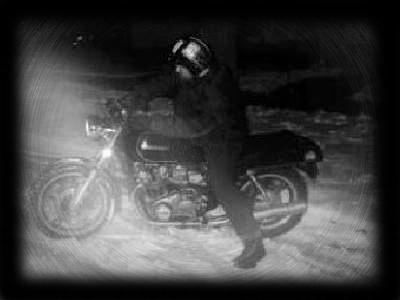By: Manzruin
Choppers and streetfighters both represent ingenuity in the face of conformity. The chopper is now a tradition, while the streetfighter is a new form of the same rule-breaking innovation that has always been the chopper's domain.

| Bad Motorcycle Manifesto By: Manzruin Choppers and streetfighters both represent ingenuity in the face of conformity. The chopper is now a tradition, while the streetfighter is a new form of the same rule-breaking innovation that has always been the chopper's domain. |
 |
| Choppers and streetfighters both commonly exhibit the minimalism, purity, and tastefulness
that can only come from the kind of creative individual who refuses to choke down
the generic product being spoon-fed to the masses. Factories are incapable of producing
culture and one should not expect otherwise. Culture is a property of the people,
and choppers and streetfighters are both manifestations of culture. Choppers originated in the early/mid part of this century in the form of the bobber. Recorded examples of bobbers date back to the forties and laid the foundation for what became known as the chopper. These early bobbers featured cut/small fenders, modified pipes and handlebars, and were stripped of most or all of their non-essential accessories. Often this would include removing the mufflers for better flow and more power. The desire for less weight and more speed led to the creation of lean, hotrodded bikes--good taste prevailed. As these bikes became more influenced by the dragstrip, their builders began taking modifications to new levels. The longer wheelbases found on drag bikes were mimicked by stretching the frame, and/or altering the rake and lengthening the forks. Low, frame-hugging seats were used to lower the center of gravity and streamline the look. Smaller gas tanks provided a combination of dragster function and street style. In 1969 the movie "Easy Rider" started the popularization that would lead to the complete chopper outbreak of the seventies. By the time Harley-Davidson produced the chopper-inspired FX Superglide in 1970, chopper builders were already retro-fitting rigid frames to the newer, hotter motors of the day. The modern chopper was officially here, and it was huge. Fast-forward to the mid-eighties. Japanese manufacturers began producing the most hardcore sport bikes that had ever seen production up to that point, in the form of bikes like the GSX-R and the Ninja. These bikes used stressed-engine frames and monoshock suspension, and were as close to a roadrace bike as anyone had ever gotten out of the box. They were eventually joined by European manufacturers Ducati and Triumph, both companies rising from the ashes. As riders immediately strove to break new ground with their riding technique, many a plastic fairing was crashed off. The chopper disease infected some of these individuals, urging them to leave the fairing off. The chopper disease had chosen to evolve, and created a new strain of it's virus that was less vulnerable to the yuppies and their tasteless over-chomed "chopper cure". The bikes were stripped bare, headlights were mounted to the forks, and traditional triple-clamps and handle bars offered the rider a more versatile, real-world riding position. These riders discovered the joy of riding a machine unencumbered by the plastic condom of a fairing which once seperated them from their machines. Fast-forward to now. The chopper is alive and well, and the streetfighter is just taking off and waiting for you to help define it. The disease is spreading. The current streetfighter builders now have more choices of frames, swingarms, and hop-up parts than ever before. The current chopper builder has a greater history of inspiration and than ever before. So chop it, drop it, strip it, stroke it, and kick out the jams #$@*&!#@$%*@! The man don't stand a chance... This article among others published in the UTMC were originally published on "Manzruin's: Bad Motorcycles for Bad People" web page, they are reprinted with the permission of Mazruin and the denziens of Bad Motorcycles for Bad People. Manzruin is another broke pschotic bastard on two wheels like the rest of us, and his commentary is always straight from his heart and straight from the heart of the new breed. |